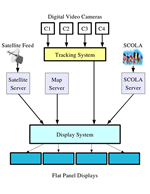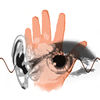 Previous
Previous
|
Students
Mike Quinn, Elec & Comp Engineering
Augsut Black, Media Arts & Tech
Brian Springer, Art Studio
Thomas Kuo, Elec & Comp Engineering
Jason Wither, Computer Science
|
Faculty
Advisors
Marko Peljhan, Media Arts & Tech
George Legrady, Media Arts & Tech
B.S. Manjunath, Elec & Comp Engineering
|
Next
 |
| |
Abstract
Spheres of Influence is an interactive
system which will be installed in UCSB's Davidson Library. It will
be located just inside the east entrance. The system will allow
a user to interact with and control global information in various
forms. This information will be conveyed to the user via four 50
inch LCD displays which will be mounted on the wall. User input
will be visual. This will be achieved by the use of 4-6 firewire
digital video cameras. The cameras will be used to track the user
or users in front of the displays. Features such as position, velocity,
color, and perhaps gesture will be extracted. The extracted information
will then be transmitted to the display system for processing.
The display component of our project will combine all of our different
data sources to create an interactive viewing experience. As the
user moves throughout the project space our vision system will update
the map data to be displayed. Through these motions the viewable
area of the map will pan and zoom, allowing the user to interactively
move the map. The multiple display environment will be implemented
using Chromium to spread a single OpenGL application over the four
displays. This will allow the displays to be tiled easily. As the
map is moved by the user, videos of news streams will be displayed
near the origin of the broadcast, allowing the user to physically
locate the source of news in different areas.
The Spheres of Influence project will also display clips
of international news from SCOLA and satellite video based on various
audio and video categorizations. Some potential categorizations
are handheld camera vs. still camera, day vs. night images, periods
of silence, and number of faces. First, the videos need to be segmented
into shots based on color histogram information. Then these shots
will be categorized by low-level color, texture, and motion descriptors
and other algorithms implemented in the OpenCV library. Further
categories can be defined by combining these low-level descriptors
for further visceral meaning. The juxtaposition of these clips will
highlight their constant presence in the media.
|
|

Example of Spheres of
Influence after installation
in a library hallway.

|
|
|
|


